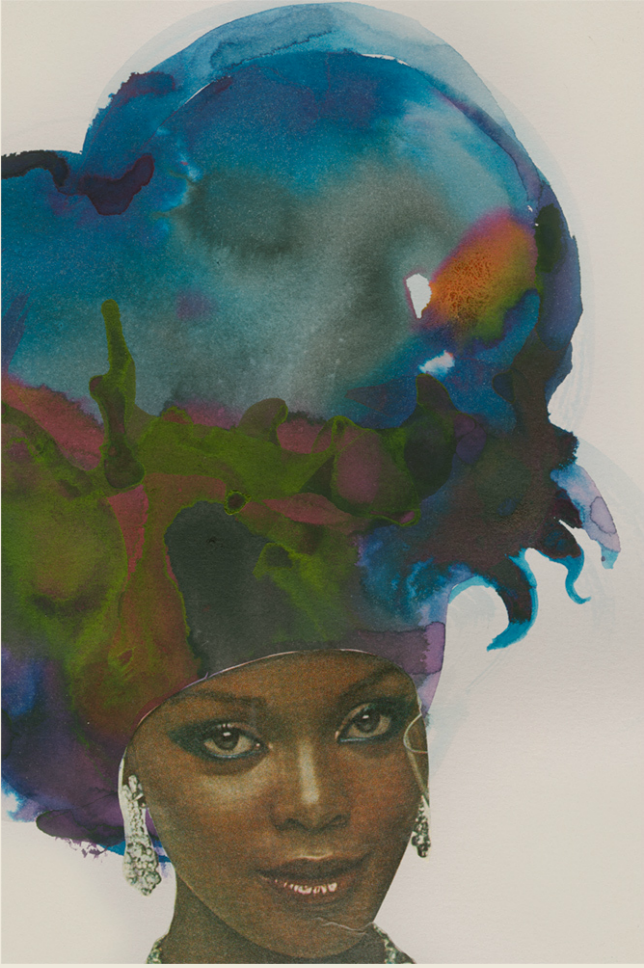
Lorna Simpson. Photo: Menelik Puryear
After we summited the ridges high above Aspen in late July of this year, the artist Lorna Simpson and I finally had the occasion to speak at length. Simpson, in town to be honored by the Aspen Art Museum with the institution’s Aspen Award for Art, had taken advantage of the good weather for a day hike. Catching our breath, we talked about her life as an artist in New York during the nineties and the Brooklyn Heights high school where her daughter and I share a common history. Simpson, a Brooklyn native, still lives in the borough, where she also keeps a studio. We caught up earlier this month to continue the conversation. Here she talks about her artistic process, creative inspiration, and the joys of working without a deadline.
I just finished this piece titled Moveableness, and in many ways, it embodies both my conceptual interests and my process as an artist. It’s based on an image that I found in an Ebony magazine from the sixties, the original image depicting a modernist interior and a woman ascending a staircase. There’s something in that image I found mesmerizing, not only in the architectural details but also in her stride.
As a next step, that image was sent to a man I work with to do my silk screening. In the case of Moveableness, the image transfer was done over several panels. With the image broken up, I was free to play with the arrangement of the individual panels, manipulating them to foreclose, showing the original in its totality. That notion of fragmentation, especially of the body, is prevalent in our culture, and it’s reflected in my works. We’re fragmented not only in terms of how society regulates our bodies but in the way we think about ourselves.
Also, too, photographs—taken by me or sourced from found imagery—have played an integral role in my practice as an artist, as is the case with Moveableness. My collages combine images of heads belonging to black women with the addition of ink washes to illustrate their hair. I can trace my original interest in found images to a discovery I made of these old Ebony magazines belonging to my grandmother. I found them really satisfying to look at, because they’re so contextual—from a particular time and for a particular audience. From there, I started collecting tons of Ebony and Jet magazines and other, similarly themed printed matter, ranging from the late 1930s through till the late 1970s. For me, the images hearken back to my childhood, but are also a lens through which to see the past fifty years in American history.
But what’s just as important as the photographic components are the more tactile, immediate elements, such as the inks I use. With ink, there’s a free-form, spontaneous quality to it that complements the more methodical process that is involved in the selection and placement of the photographic or found image. Working with ink is very much about being in the moment, and as a result there’s a degree of subconsciousness that comes through. It’s not the kind of process where you can go, Okay, that side’s going to be red, and it’s going to look like this. It has a very immediate, in-the-moment kind of flow to it. It requires you to make split-second decisions in the way you handle ink or the way ink flows on any given surface—that’s always surprising to me.

Photo: Menelik Puryear
I’m just coming off having works in several large exhibitions, including the Venice Biennale, and there was a traveling exhibition of my work that started in 2013. And so now I’m just getting back into my studio without the pressure or intention of painting with a quick and fast dealing looming over me. I’m looking forward to spending time with my work, thinking about what I’m doing with it. For the last nine months now, I’ve been working out of this three-thousand-square-foot studio, which, when I first started making pieces here, was quite an intense shift in scale—it’s really affected my approach to my paintings.

Photo: Menelik Puryear

Photo: Menelik Puryear
Without any specific show on the horizon, my routine has taken on a different rhythm as well. When I wake up in the morning, I usually begin with meditation before focusing on what the day ahead holds for me. I’ve come to rely on my studio assistant to help cordon off elements of the organizational, day-to-day practicalities that can sometimes become overwhelming. That allows me to create a space where I can focus on what I want to think about in terms of my work. When that mental space, that buffer, is there, I’m able to step away from the madness of things. And it’s wonderful.
Joseph Akel is a writer and editor based in New York City and San Francisco. A regular contributor to Frieze, the New York Times, and Artforum, among others, he’s a Ph.D. candidate in the University of California, Berkeley’s Rhetoric Department. Most recently he edited and contributed an essay to the forthcoming publication Wolves Like Us, a photographic series depicting the Angulo Brothers, subjects of the documentary The Wolfpack.
